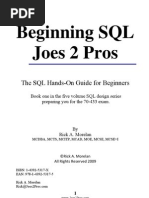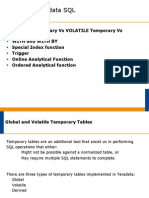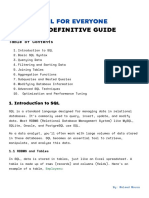0 ratings0% found this document useful (0 votes)
206 viewsSQL For Everyone (Definitive Guide)
SQL
Uploaded by
Pradeep KumarCopyright
© © All Rights Reserved
We take content rights seriously. If you suspect this is your content, claim it here.
Available Formats
Download as PDF or read online on Scribd
0 ratings0% found this document useful (0 votes)
206 viewsSQL For Everyone (Definitive Guide)
SQL
Uploaded by
Pradeep KumarCopyright
© © All Rights Reserved
We take content rights seriously. If you suspect this is your content, claim it here.
Available Formats
Download as PDF or read online on Scribd
You are on page 1/ 10
SQL FOR EVERYONE
THE DEFINITIVE GUIDE
[NOTES GALLERY (CREATE BY - ATUL KUMAR (LINKEDIN)
Table of Contents
. Introduction to SQL
- Basic SQL Syntax
- Querying Data
. Filtering and Sorting Data
. Joining Tables
. Aggregation Functions
. Subqueries and Nested Queries
. Modifying Database Information
. Advanced SQL Techniques
10. Optimization and Performance Tuning
1. Introduction to SQL
SQL is a standard language designed for managing data in relational
databases. It's commonly used to query, insert, update, and modify
data. Most RDBMS (Relational Database Management System) like MySQL,
SQLite, Oracle, and PostgreSQL use SQL.
As a data analyst, you'll often work with large volumes of data stored
in these databases. SQL becomes an essential tool to retrieve,
manipulate, and analyze this data.
1.1 RDBMS and Tables
In SQL, data is stored in tables, just like an Excel spreadsheet. A
table is made up of rows (records) and columns (fields). Here's an
example of a table, Employees:
FirstName Position
John Doe Analyst
Jane Doe Engineer
Mary Johnson Manager
2. Basic SQL Syntax
Let's look at the fundamental SQL commands: SELECT, FROM, WHERE, GROUP
BY, HAVING, and ORDER BY.
2.4 SELECT and FROM
The SELECT statement is used to select data from a database, and the
FROM statement specifies which table to get the data from.
SELECT FirstName, LastName
FROM Employees;
This query retrieves all first and last names from the Employees table.
If you want to select all columns, use the * symbol:
SELECT * FROM Employees;
2.2 WHERE
The WHERE clause is used to filter records:
SELECT *
FROM Employees
WHERE Position = ‘Analyst’
This query retrieves all data for employees who are analysts.
(NOTES GALLERY
2.3 GROUP BY and HAVING
GROUP BY groups rows that have the same values in specified columns into
aggregated data. HAVING is used instead of WHERE with aggregated data.
SELECT Position, COUNT(*)
ROM Employees
GROUP BY Posit
HAVING COUNT(*) > 13
This query shows positions held by more than one employee.
2.4 ORDER BY
ORDER BY is used to sort the data in ascending or descending order:
SELECT *
FROM Employees
ORDER BY LastName ASC;
This query sorts employees by their last name in ascending order.
3. Querying Data
The SELECT statement is not just for selecting simple rows. We can use
it to perform calculations, concatenations, and more.
SELECT FirstName || ' ' || LastName as FullName, Position
FROM Employees;
This query concatenates the first and last names, separated by a space,
and displays it as FullName.
4. Filtering and Sorting Data
Apart from WHERE and ORDER BY, SQL offers BETWEEN, LIKE, and IN to
filter data.
S]NOTES GALLERY
4.1 BETWEEN
BETWEEN is used to filter by a range:
SELECT *
FROM Orders
WHERE OrderDate BETWEEN '2023-01-01' AND '2023-12-31';
This query selects all orders placed in the year 2023.
4.2 LIKE and ILIKE
LIKE is used in a WHERE clause to search for a specified pattern in a
column. The "%" sign is used to define wildcards (missing letters) both
before and after the pattern. Also, note that LIKE is case sensitive.
ILIKE can be used for case-insensitive search.
SELECT *
FROM Employees
WHERE FirstName LIKE '3%";
This query selects all employees with a first name starting with ‘J’.
4.3 IN
IN allows you to specify multiple values in a WHERE clause:
SELECT *
FROM Employees
WHERE Position IN (‘Analyst', ‘Engineer’);
(NOTES GALLERY
This query selects all analysts and engineers.
5. Joining Tables
JOIN statements are used to combine rows from two or more tables based
on a related column. The different types of joins include INNER JOIN,
LEFT (OUTER) JOIN, RIGHT (OUTER) JOIN, and FULL (OUTER) JOIN.
Consider this additional table, Departments:
DepartmentID Departmentiiame
[ar
| Sales
[a
And suppose we add a DepartmentID field to the Employees table. Here's
how we can use different types of joins:
5.1 INNER JOIN
SELECT Employees.LastName, Employees.FirstName, Departments .DepartmentName
FROM Employees
INNER JOIN Departments ON Employees.DepartmentID = Departments.DepartmentID;
This query retrieves the list of employees along with their respective
department names.
5.2 LEFT (OUTER) JOIN
SELECT Employees.LastName, Employees.FirstName, Departments. DepartmentName
FROM Employees
LEFT JOIN Departments ON Employees.DepartmentID = Departments .DepartmentID;
This query retrieves all employees and their departments, including
employees with no department (the DepartmentName for them will be
NULL).
5.3 RIGHT (OUTER) JOIN
SELECT Employees.LastName, Employees.FirstName, Departments.DepartmentName
FROM Employees
RIGHT JOIN Departments ON Employees.DepartmentID = Departments .DepartmentID;
This query retrieves all departments and their employees, including
departments with no employees.
5.4 FULL (OUTER) JOIN
SELECT Employees.LastName, Employees.FirstName, Departments .DepartmentName
FROM Employees
FULL JOIN Departments ON Employees.DepartmentID = Departments.DepartmentID;
This query retrieves all combinations of employees and departments,
including employees with no department and departments with no
employees .
6. Aggregation Functions
SQL provides several functions to perform calculations on data, such as
COUNT(), SUM(), AVG(), MIN(), MAX(), and GROUP_CONCAT().
SELECT COUNT(*)
FROM Orders,
WHERE OrderDate BETWEEN '2023-@1-01' AND ‘2023-12-31';
This query returns the total number of orders placed in the year 2023.
7. Subqueries and Nested Queries
A subquery is a SQL query nested inside a larger query. A subquery may
oceur in:
@ A SELECT clause
A FROM clause
A WHERE clause
The subquery can be nested inside a SELECT, INSERT, UPDATE, or DELETE
statement or inside another subquery.
SELECT EmployeeID, FirstName, Position
FROM Employees
WHERE EmployeeID IN (SELECT EmployeeID FROM Orders WHERE OrderTotal > 1000);
This query selects all employees who have made orders totaling more
than 1000.
8. Modifying Database Information
SQL allows you to insert, update, and delete data with INSERT, UPDATE,
and DELETE commands respectively. Be careful when using these commands
as you can change your data permanently.
8.1 INSERT
INSERT INTO Employees (EmployeeID, FirstName, LastName, Position)
VALUES (4, ‘Mark’, ‘Anderson’, ‘Analyst');
This query adds a new row to the Employees table.
8.2 UPDATE
UPDATE Employees
SET Position = ‘Senior Analyst’
WHERE EmployeeID = 4;
This query changes Mark Anderson's position to Senior Analyst.
8.3 DELETE
DELETE FROM Employees WHERE EmployeeID = 4;
This query deletes Mark Anderson's record from the Employees table.
9. Advanced SQL Techniques
Let's delve into more complex techniques with the help of examples.
9.1 Handling NULL values
NULL value in SQL means no or zero value. Here's how you can use IS
NULL and IS NOT NULL:
SELECT *
FROM Employees
WHERE DepartmentID IS NULL;
This query selects all employees who don't belong to any department.
SELECT *
FROM Employees
WHERE DepartmentID IS NOT NULL;
This query selects all employees who belong to a department.
9.2 String Functions
SQL offers several functions to manipulate strings. Some examples
include:
* CONCAT(): Concatenates two or more strings.
© TRIM(): Removes leading and trailing spaces of a string.
* LENGTH(): Returns the length of a string.
SELECT CONCAT(FirstName, ' ', LastName) as FullName, TRIM(Position),
LENGTH(FirstName) as NameLength
FROM Employees;
This query retrieves a full name by combining first and last names, the
position after removing leading and trailing spaces, and the length of
the first name.
9.3 Date and Time Functions
SQL provides many functions to work with date and time. Some examples
include:
NOW(): Returns the current date and time.
* CURDATE(): Returns the current date.
CURTIME(): Returns the current time.
SELECT OrderID, OrderTotal, NOW() as QueryTime
FROM Orders.
WHERE OrderDate = CURDATE();
This query retrieves today’s orders along with the query execution
time.
9.4 Case Statements
Case statements help in implementing conditional logic in SQL:
SELECT FirstName, Position,
CASE
WHEN Position = ‘Analyst’ THEN ‘Junior Level’
WHEN Position = ‘Engineer’ THEN ‘Mid Level’
ELSE ‘Senior Level’
END as JobLevel
FROM Employees;
This query categorizes employees into job levels based on their
positions.
9.5 Window Functions
Window functions perform calculations across a set of table rows that
are related to the current row:
SELECT FirstName, Position, Salary,
RANK() OVER (PARTITION BY Position ORDER BY Salary DESC) as Rank
FROM Employees;
This query ranks employees within their respective positions based on
their salaries.
10. Optimization and Performance Tuning
Here are some examples demonstrating SQL optimization techniques:
10.1 EXPLAIN
Most SQL databases support the EXPLAIN command, which shows the
execution plan of an SQL statement. This can help you understand how
your SQL query will be executed and where you can optimize it.
EXPLAIN SELECT * FROM Employees;
10.2 Avoid SELECT *
Rather than using SELECT *, specify the columns you need. This reduces
the amount of data that needs to be read from the disk.
SELECT FirstName, LastName FROM Employees;
10.3 Use LIMIT
If you only need a specific number of rows, use LIMIT to prevent reading
unnecessary data.
SELECT * FROM Employees ORDER BY Salary DESC LIMIT 10;
This query gets the top 10 employees with the highest salaries.
10.4 Index your data
Indexing your data can significantly speed up data retrieval times.
Here's how you can add an index:
CREATE INDEX idx_employees_position ON Employees(Position);
NOTES GALLERY
CREATE BY - ATUL KUMAR (LINKEDIN)
You might also like
- 100 SQL Formulas Each Student Should KnowNo ratings yet100 SQL Formulas Each Student Should Know10 pages
- Create Int Varchar Date Varchar State Varchar: Emp - Piyush Employeeid Empname 30 Dob City 20 20100% (1)Create Int Varchar Date Varchar State Varchar: Emp - Piyush Employeeid Empname 30 Dob City 20 2010 pages
- Cleaning Dirty Data With Pandas & Python - DevelopIntelligence Blog PDFNo ratings yetCleaning Dirty Data With Pandas & Python - DevelopIntelligence Blog PDF8 pages
- Perofrmance and Indexes Discussion Questions Solutions PDFNo ratings yetPerofrmance and Indexes Discussion Questions Solutions PDF5 pages
- Python Question Bank Complete 100 QuestionNo ratings yetPython Question Bank Complete 100 Question23 pages
- ADD Add Constraint Alter: Keyword DescriptionNo ratings yetADD Add Constraint Alter: Keyword Description5 pages
- Server.: String Functions Provided by SQLNo ratings yetServer.: String Functions Provided by SQL8 pages
- Basic SQL: ITCS 201 Web Programming Part IINo ratings yetBasic SQL: ITCS 201 Web Programming Part II29 pages



























































